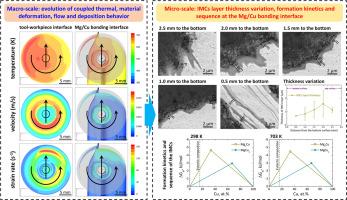Dissimilar friction stir welding between AZ31 magnesium alloy and pure copper: Evolution mechanism from macro to micro scales
IF 13.8
1区 材料科学
Q1 METALLURGY & METALLURGICAL ENGINEERING
引用次数: 0
Abstract
High-quality joining between Mg and Cu based alloys was still a huge challenge due to excessive formation of detrimental intermetallic compounds (IMCs) by most of the conventional welding and joining methods. In this study, with controlling heat input and intensifying dissimilar material deformation and intermixing, friction stir welding (FSW) technique was employed for the joining between AZ31 Mg and T2 copper, and the process mechanism was elucidated at both macro and micro scales by combining experimental and numerical approaches. First, a process-based contact boundary was proposed for a precise description of the condition at the interface between the tool and the redistributed dissimilar Mg/Cu materials. Second, defect-free Mg/Cu FSW joints were obtained by using Mg-RS/Cu-AS configuration. With the tool offset of 1.0 mm to Cu-AS, the maximum temperature in the stirring zone was 710 K, which was lower than the minimum eutectic temperature of Mg-Cu binary system. Third, over 5-times difference of flow stresses resulted in upward and downward materials transfer, and also different flow-deposition behaviors of Mg and Cu, respectively, with effect of the rotating tool, which finally caused the elongation of Mg/Cu interface. The thickness variation of IMCs layer ranging 0.5–2.5 µm was originated from the inconsistent evolution of temperature, velocity and strain rate at different locations. Both Mg2Cu and MgCu2 IMC phases were observed, and the Mg2Cu layer was first generated, grown faster and finally much thicker than the MgCu2 layer. Moreover, an elongated and continuous IMCs layer was advantageous for achieving Mg/Cu joining strength over 124 MPa, which was greatly improved comparing with the published results.

AZ31镁合金与纯铜异种搅拌摩擦焊:从宏观到微观的演化机理
由于大多数传统的焊接和连接方法会产生有害的金属间化合物(IMCs),因此高质量的Mg和Cu基合金连接仍然是一个巨大的挑战。本研究在控制热输入、强化异种材料变形和混合的条件下,采用搅拌摩擦焊(FSW)技术进行AZ31 Mg与T2铜的连接,并通过实验与数值相结合的方法从宏观和微观两个尺度上阐明了这一过程的机理。首先,提出了一种基于工艺的接触边界,以精确描述刀具与重分布的异种Mg/Cu材料之间的界面条件。其次,采用Mg- rs /Cu- as结构获得无缺陷的Mg/Cu FSW接头。当刀具与Cu-AS偏移1.0 mm时,搅拌区的最高温度为710 K,低于Mg-Cu二元体系的最低共晶温度。③流动应力差超过5倍,在旋转刀具的作用下,导致材料向上和向下传递,Mg和Cu的流动沉积行为也不同,最终导致Mg/Cu界面伸长。0.5 ~ 2.5µm范围内IMCs层厚度的变化是由于不同位置温度、速度和应变速率的不一致演变造成的。Mg2Cu和MgCu2均有IMC相,Mg2Cu层首先生成,生长速度更快,最终比MgCu2层厚很多。此外,延长且连续的IMCs层有利于实现超过124 MPa的Mg/Cu连接强度,与已发表的结果相比,Mg/Cu连接强度大大提高。
本文章由计算机程序翻译,如有差异,请以英文原文为准。
求助全文
约1分钟内获得全文
求助全文
来源期刊

Journal of Magnesium and Alloys
Engineering-Mechanics of Materials
CiteScore
20.20
自引率
14.80%
发文量
52
审稿时长
59 days
期刊介绍:
The Journal of Magnesium and Alloys serves as a global platform for both theoretical and experimental studies in magnesium science and engineering. It welcomes submissions investigating various scientific and engineering factors impacting the metallurgy, processing, microstructure, properties, and applications of magnesium and alloys. The journal covers all aspects of magnesium and alloy research, including raw materials, alloy casting, extrusion and deformation, corrosion and surface treatment, joining and machining, simulation and modeling, microstructure evolution and mechanical properties, new alloy development, magnesium-based composites, bio-materials and energy materials, applications, and recycling.
 求助内容:
求助内容: 应助结果提醒方式:
应助结果提醒方式:


